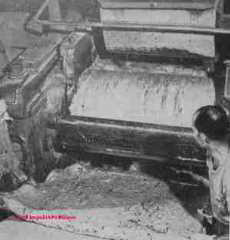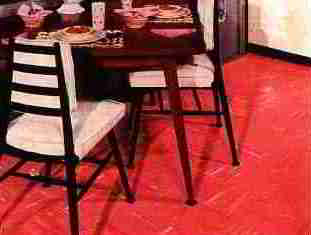 Asbestos Floor Tile Manufacturing Processes
Asbestos Floor Tile Manufacturing Processes
History, Manufacture, Asbestos-Content &
Identification of Asbestos Floor Tiles
- POST a QUESTION or COMMENT about what building materials may contain asbestos, visual identification of asbestos-containing materials in buildings, and possible asbestos material identification by testing, use, age, appearance
Asbestos floor tile manufacturing process & contents: this article describes how asphalt asbestos floor tiles & vinyl asbestos floor tiles were produced, their ingredients and the equipment used to make them.
We include data on athe estimaged production levels of asphalt-based flooring products in square feet by type and material. Our page top photograph illustrates popular and widely-installed Armstrong™ vinyl asbestos floor tiles.
This articles series about the manufacture & use of asbestos-containing products includes detailed information on the production methods, asbestos content, and the identity and use of asbestos-containing materials.
InspectAPedia tolerates no conflicts of interest. We have no relationship with advertisers, products, or services discussed at this website.
- Daniel Friedman, Publisher/Editor/Author - See WHO ARE WE?
Asbestos Floor Tile Manufacturing Procedures
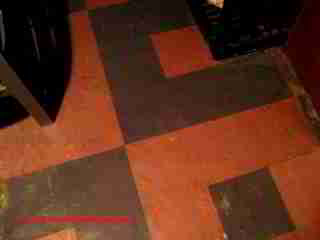 Article Contents
Article Contents
- ASBESTOS TILE MANUFACTURE
- LEAD in FLOORING PRODUCTS & POLISHES - separate article
Introduction to the Manufactur of Asbestos-Containing Flooring
The following text is Adapted from Rosato (1959) p. 86-93 [1] © 2021 InspectApedia.com
In the past few decades [into the 1950's ] there has been a gradual development and increase in the use of tile. Vinyl floor tile and asphalt floor tile can use as much as 30 to 50 per cent, by weight, of asbestos shorts and floats. See Figure 4.1 below.
Shown at left, Sears vinyl-asbestos flooring. [Click to enlarge any image]
Sometimes, longer fibers are used; however, it is rare inasmuch as they are more expensive and tend to interfere with producing smoothly surfaced tiles. Asbestos is also used in the manufacture of synthetic resin tile.
Resilient floor coverings identify such organic types as asphalt tile, rubber tile, linoleum, and plastic tile. The nonresilient floor coverings pertain to stone, brick, etc. The original resilient floor coverings were developed during the latter part of the Nineteenth Century by Frederick Walton.
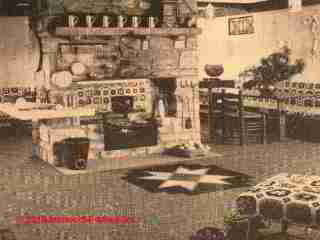 The original covering was linoleum for use as a floor decking
on British naval ships. Asphalt tile was first made as amastic type of floor covering.
The original covering was linoleum for use as a floor decking
on British naval ships. Asphalt tile was first made as amastic type of floor covering.
The mastic was troweled on the floor. In 1917, the United States Navy used the mastic as a deck covering over wood. The original mixes included asphaltic binders, with fillers of asbestos; mixing was done on a rubber mill.
Shown at left: Figure 4.1. View of asphalt tile floor with pattern. (Courtesy Armstrong Floor Div.)
It has been reported that the asphalt tile industry had its beginning in 1920 when the asphalt roofing manufacturers attempted to develop a material similar to slate shingles. The material developed was not suitable for shingles, but it started the asphalt floor tile business.
The term tile generally identifies tiles using asphalt materials as the principal binder; such organic resin binders as vinyl are used too, because they permit the manufacture of light-colored products. Vinyl asbestos tile competes with asphalt tile.
Both of these markets are expanding , however, the vinyl market is expanding faster. [That is to say, asbestos-based floor tile tile markets were still significantly expanding in 1959 - Ed.]
Asbestos Tile Production Growth Beginning From 1920
The first publicized installation of asphalt tile was in the Western Union office in New York City (1920). By the end of 1930 3 million sq yd was being produced annually.
Growth of Annual Production Rate of Asbestos-Flooring 1920 - 1952 |
||
previous interval |
||
| 1920 - first public building installation | Western Union Office, New York City | |
| 1930 | 3 million square yards | |
| 1936 | 4.5 million square yards | + 50% |
| 1945 | 41 million square yards | + 1000%, +12% greater than during WWII |
| 1949 | 61 million square yards | + 148 % |
| 1952 (Asphalt) | 90 million square yards | + 147% |
| 1952 (Vinyl asbestos tile) | 40 million square yards | |
| 1952 (Vinyl, homogeneous) | 40 million square yards | |
Notes to the table above
Adapted from original text, Rosato (1959) p88.
The [early] gradual growth in asphalt tiling [in the 1930's] had a sudden expansion during World War II, in both industrial and commercial applications. The growth in asphalt tile during World War II had been caused by shortages of the important raw materials required for the more standard flooring products. The military requirements activated more development in the field of asphalt and vinyl tiles
By 1936 it had reached 4 1/2 million sq yd per year. Approximately five per cent of the floor covering in 1940 was of asphalt tile. After World War II, the volume increased to twelve per cent or approximately 41,000,000 sq yd of asphalt tile. In 1949 with the post-war building boom, there was an annual production of 61 million sq yd.
Annual production of vinyl plastic tile in 1952 was approximately 35 million sq yd. Reports indicate that in 1952 vinyl plastic tile production was approximately one-half of asphalt tile production. See Table 4.1 for estimated production.
TABLE 4.1. Estimated Production of Asbestos-Containing Floor Tiles / Sheet Flooring |
||
| Printed enamel | 200 million | 45 |
| Asphalt tile | 90 million | 20 |
| Linoleum | 58 million | 13 |
| Vinyl asbestos tile | 40 million | 9 |
| Vinyl (homogeneoust) | 40 million | 9 |
| Rubber flooring | 12 million | 3.3 |
| Cork flooring | 4 million | 0.7 |
| Total | 443 million | 100 |
Notes to the table above
Adapted from Rosato (1959) (1950) Table 4.3 [1]
TABLE 4.1. part 2: Asbestos FLooring Yard Goods & Tiles |
||
| Total yardage | 443 million | 100% |
| Yard Goods (sheet flooring) | 260 million | 59% |
| Tile Flooring | 183 million | 41% |
| Yard goods total (sheet flooring) | 260 million | 100% |
| Printed enamel | 200 million | 77.2% |
| Linoleum | 38 million | 15% |
| Vinyl (homogeneous) | 20 million | 15% |
| Rubber | 2 million | |
| Tile flooring total | 183 million | 100% |
| Asphalt-asbestos | 90 million | 49% |
| Vinyl-asbestos | 40 million | 22% |
| Linoleum | 20 million | 11% |
| Vinyl-asbestos (homogeneous) | 20 million | 11% |
| Rubber | 10 million | 5% |
| Cork | 3 million | 2% |
Notes to the table above
Also see ASBESTOS FLOOR TILE PRODUCT NAMES
Manufacturing Processes Used for Asbestos Floor Tiles
Figures 4.2 and 4.3 show some of the operations involving the preparation and manufacture of tiles. The usual procedure is to combine plasticized resin with filler for the resin tile and asphalt with filler for the asphalt tile.
Banbury mixers are generally used to mix the basic material. In the case of asphalt mixes, the. binder softens at moderately low temperatures. A steam-heated jacket is generally used with the mixer in order to soften the mix.
Pigments and other fillers are added during the mixing operation. After the mixes are completel blended with coloring matter, they are fed through calenders in order to produce smooth sheets of specified thickness. Then, these sheets are cut to proper size, prior to the material cooling and hardening.
Asphalt Tile Material Contents
Asphalt floor tile was originally manufactured with heavy asphalt solutions mixed with a very high percentage of asbestos filler. The tiles were hardened by means of solvent evaporation. Hot mixed asphalt solutions were also used.
These tiles were black or extremely dark in color. In order to obtain a different color, brown or intermediate colors, gilsonite is used.
Figure 4.2. The original doughy mass for tile is a heavy caramel-like sheet. Sheeting-mill operators pull it from the machine and lay it on a conveyor belt, which will take it to the calender rolls for thinning out. (Courtesy Kentile, Inc.)
Gilsonite is usually approximately 90 per cent soluble in carbon disulfide but its solubility in petroleum naphtha varies from 10 to 60 per cent. It is miscible in all proportions with drying oils and with the resins commonly used in making varnishes.
Unlike other asphalts, it can mix in almost any proportion with waxes to form stable compounds.
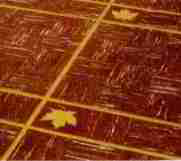 Gilsonite alone is hard and brittle. It requires softening
in the manufacture of tile products. Soft asphalts or pitches
can be used to soften gilsonite.
Gilsonite alone is hard and brittle. It requires softening
in the manufacture of tile products. Soft asphalts or pitches
can be used to soften gilsonite.
A typical formula for dark colored tile includes 40 parts by weight of asphalt or gilsonite, 60 parts of asbestos floats, 30 parts of powdered limestone, and pigment as required.
Another typical mixture includes 70 per cent asbestos fiber, 15 per cent gilsonite, 15 per cent vegetable pitch, and sufficient coloring.
The vegetable pitch provides for the proper flow of the binder.
The nomenclature of asphalt tile is misleading. The original asphalt tile contained a high percentage of asphalt; however, modern asphalt tile contains very little or no asphalt. Rather than the use of asphalt or gilsonite, most of the binders used now are synthetic organic resins.
The additives or plasticizers used with the resins are vegetable or petroleum pitches. These synthetic binders produce a brighter, lighter, and wider range of colors. Asbestos fillers however, are still the main ingredient in asphalt tile.
Figure 4.3. Continuous flow of floor tile moving from mill at rear through polished calender rolls on the production line—side view.
The coumarone-indene resins are the principal resins used 92 Asbestos Tile 93 in asphalt tile manufacture. They are readily fusible and resistant to water and the alkalies which makes them well adapted to tile manufacture.
When using coumarone-indene resins, the tile is brittle. Plasticizers are required in order to soften the tile. A general procedure is to mix vegetable and animal pitches in a dispersion of the resin in oil.
For a light-colored tile a conventional mixture is coumarone-indene resin of 22 parts, cottonseed pitch of 20 parts, asbestos of 65 parts, powdered limestone of 35 parts and pigments as required. Other mixes include a two to one ratio of coumarone-indene resin with the various pitches.
When marbleized tile is to be manufactured, the marbleizing color is added to the mixture at the end of the mixing operation. Generally this coloring matter is prepared in a mixture which has a slightly higher melting point so that it does not flow too readily when mixed with other compounds.
Summary of Typical Ingredients in Asphalt-Asbestos Floor Tile by Percent
Rosato cites another flooring material from the 1950's called asbetic flooring which was a mixture of ground mother rock and the shortest, otherwise unusable asbestos fibers.
Other sources such as the Rotterdam Convention PIC archive, [citation needed] note that while vinyl-asbestos floor tile ingredient mixes varied by manufacturer, typically vinyl-asbestos floor tiles contained:
- Asbestos - 5 - 25%
- Binder - 15 - 20%
- Limestone - 53 - 73% [note that some products used asbestos powder as filler]
- Plasticizer - 5%
- Stabilizer - 1 - 2%
- Pigment - 0.5 - 5%
Short asbestos fibers may also be among the more hazardous if airborne. Asbestos was also used in a mixture with waterglass (a clear binder used in many chemical applications and even for cementing stove gaskets) as a hard binding compound.
Vinyl-Asbestos Tile Material Contents
 Vinyl resin is the most important type of
plastic floor tile. The use of vinyl resin in floor coverings
started after World War II. These floor coverings can be
made in many different colors (light and dark).
Vinyl resin is the most important type of
plastic floor tile. The use of vinyl resin in floor coverings
started after World War II. These floor coverings can be
made in many different colors (light and dark).
Similar to asphalt tile, but generally more flexible, vinyl asbestos tile has the largest volume of sales of the vinyl flooring family. The annual production rate is estimated at more than 80 million sq yd; the tile produced is usually 9 in. by 9 in. and 1/16 in. thick. Commercial installations usually use 1/8 in. tile.
Shown at left, Ever-Wear vinyl-asbestos floor tiles.
Vinyl-asbestos tile is used above or below grade on smooth wood or concrete base. As it wears, it gets smoother and takes waxing very well. Its resistance to scratching or marring and to strong detergents is excellent.
The batch type-continuous process type of flooring is made by a combination batch type and continuous process.
It consists of vinyl-chloride vinyl-acetate copolymer resin mixed with plasticizers, stabilizers, asbestos, limestone and color pigments.
Varying types of intensive mixing equipment are used to fuse these ingredients into a hot mass of the base, or field color.
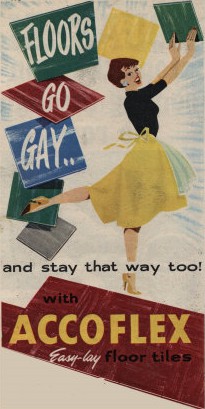 Then, this base can be decorated on
a two-roll differential speed mill by adding previously made
granules of the proper shapes and colors to produce the
desired design.
Then, this base can be decorated on
a two-roll differential speed mill by adding previously made
granules of the proper shapes and colors to produce the
desired design.
A thick blanket of stock is cut from this mill when the pattern is right; it is butted to the previous slab and fed into a two-roll calender which squeezes it to what is almost the required thickness. From this point, the process is continuous as the sheet passes through a second and often a third two-roll calender, cooling equipment and then a blanking press.
Shown at left, Armstrong Accoflex 1950's vintage asphalt-based floor tile advertisement.
See ARMSTRONG FLOOR TILES for a guide to identifying Armstrong asbestos floor tiles.
In the press, depending upon the width of the sheet two rows of three to five tiles are die cut from the sheet per stamping.
The rest of the sheet travels back on an overhead conveyor to the mixer, for immediate reworking, while the tiles move along to be visually inspected for pattern, color and surface appearance.
An entirely different approach to the processing of vinyl resins into flooring materials is the use of vinyl plastisols or organosols. These materials are dispersions of vinyl resins in plasticizer (plastisols) or combinations of plasticizer and volatile diluent (organosols).
These dispersions are of a fluid nature; the methods for their application are based on their flow characteristic, on their ability, when heated to 350°F to fuse into the same tough resilient vinyl plastic that requires the above-described heavy processing techniques.
Another application of asbestos with vinyl tile involves the use of asphalt saturated asbestos felt applied under 1/8 in. thick tile.
This felt underlay provides for smoother finished flooring.
Do Asbestos-Containing Floor Tiles or Sheet Flooring Also Contain Lead Contaminants?
This discussion has moved to LEAD in FLOORING PRODUCTS & POLISHES - separate article.
...
Continue reading at ASBESTOS INSULATION or select a topic from the closely-related articles below, or see the complete ARTICLE INDEX.
Or see these
Recommended Articles
Suggested citation for this web page
ASBESTOS TILE MANUFACTURE at InspectApedia.com - online encyclopedia of building & environmental inspection, testing, diagnosis, repair, & problem prevention advice.
Or see this
INDEX to RELATED ARTICLES: ARTICLE INDEX to ASBESTOS HAZARDS
Or use the SEARCH BOX found below to Ask a Question or Search InspectApedia
Ask a Question or Search InspectApedia
Try the search box just below, or if you prefer, post a question or comment in the Comments box below and we will respond promptly.
Search the InspectApedia website
Note: appearance of your Comment below may be delayed: if your comment contains an image, photograph, web link, or text that looks to the software as if it might be a web link, your posting will appear after it has been approved by a moderator. Apologies for the delay.
Only one image can be added per comment but you can post as many comments, and therefore images, as you like.
You will not receive a notification when a response to your question has been posted.
Please bookmark this page to make it easy for you to check back for our response.
IF above you see "Comment Form is loading comments..." then COMMENT BOX - countable.ca / bawkbox.com IS NOT WORKING.
In any case you are welcome to send an email directly to us at InspectApedia.com at editor@inspectApedia.com
We'll reply to you directly. Please help us help you by noting, in your email, the URL of the InspectApedia page where you wanted to comment.
Citations & References
In addition to any citations in the article above, a full list is available on request.
- [1] ASBESTOS HISTORY & PROPERTIES [Book online] D.V. Roasato, engineering consultant, Newton MA, Reinhold Publishing Co., NY, 1959, Library of Congress Catalog No. 59-12535. We are in process of re-publishing this interesting text. Excerpts & adaptations are found in InspectApedia.com articles on asbestos history, production & visual identification in and on buildings.
- [2] "Asbestos in Plastic Compositions", A.B. Cummins, Modern Plastics [un-dated, pre 1952]
- [3] "Asbestos in Your Home," Spokane County Air Pollution Control Authority, Spokane WA 509-477-4727 www.scapa.org provides a one-page image, a .pdf file drawing of a house warning of some possible sources of asbestos in the home. The sources are not ranked according to actual risk of releasing hazardous levels of airborne asbestos fibers and the list is useful but incomplete.
- [4] The US EPA provides a sample list of asbestos containing products epa.gov/earth1r6/6pd/asbestos/asbmatl.htm
- [5] "Characterization of asbestos exposure among automotive mechanics servicing and handling asbestos-containing materials", Gary Scott Dotson, University of South Florida, 1 June 2006, web search 3/9/2012 original source: scholarcommons.usf.edu/cgi/viewcontent.cgi?article=3505&context=etd [copy on file as /hazmat/Automotive_Asbestos_Exposure.pdf ].
- [6] Asbestos Identification and Testing References
- Asbestos Identification, Walter C.McCrone, McCrone Research Institute, Chicago, IL.1987 ISBN 0-904962-11-3. Dr. McCrone literally "wrote the book" on asbestos identification procedures which formed the basis for current work by asbestos identification laboratories.
- Stanton, .F., et al., National Bureau of Standards Special Publication 506: 143-151
- Pott, F., Staub-Reinhalf Luft 38, 486-490 (1978) cited by McCrone
- [6] ASBESTOS IN YOUR HOME U.S. EPA, Exposure Evaluation Division, Office of Toxic Substances, Office of Pesticides and Toxic Substances, U.S. Environmental Protection Agency, Washington,D.C. 20460
- [7] Asbestos products and their history and use in various building materials such as asphalt and vinyl flooring includes discussion which draws on ASBESTOS, ITS INDUSTRIAL APPLICATIONS, ROSATO 1959, D.V. Rosato, engineering consultant, Newton, MA, Reinhold Publishing, 1959 Library of Congress Catalog Card No.: 59-12535 (out of print, text and images available at InspectAPedia.com).
- [8] "Handling Asbestos-Containing roofing material - an update", Carl Good, NRCA Associate Executive Director, Professional Roofing, February 1992, p. 38-43
- [9] EPA Guidance for Controlling Asbestos-Containing Materials in buildings, NIAST, National Institute on Abatement Sciences & Technology, [republishing EPA public documents] 1985 ed., Exposure Evaluation Division, Office of Toxic Substances, Office of Pesticides and Toxic Substances, U.S. Environmental Protection Agency, Washington,D.C. 20460
- EPA ASBESTOS MATERIALS BAN: CLARIFICATION 1999
- Basic Information about Asbestos, US EPA, web search 08/17/2010, original source: http://www.epa.gov/asbestos/pubs/help.html
- "Handling Asbestos-Containing roofing material - an update", Carl Good, NRCA Associate Executive Director, Professional Roofing, February 1992, p. 38-43
- EPA Guidance for Controlling Asbestos-Containing Materials in buildings, NIAST, National Institute on Abatement Sciences & Technology, [republishing EPA public documents] 1985 ed., Exposure Evaluation Division, Office of Toxic Substances, Office of Pesticides and Toxic Substances, U.S. Environmental Protection Agency, Washington,D.C. 20460
- EPA, ASBESTOS IN YOUR HOME [PDF] - U.S. EPA, Exposure Evaluation Division, Office of Toxic Substances, Office of Pesticides and Toxic Substances, U.S. Environmental Protection Agency, Washington,D.C. 20460
- Vermiculite:
Protect Your Family from Asbestos-Contaminated Vermiculite Insulation, U.S. EPA , web search 08/17/2010, original source: http://www.epa.gov/asbestos/pubs/verm.html
Web search 01/20/2011, original source: http://epa.gov/asbestos/pubs/verm_questions.html - Proteja su familia del aislante de vermiculita contaminado con asbesto, U.S. EPA HOJA INFORMATIVA - Proteja a su familia del aislante de vermiculita contaminado con asbestos, web search 08/17/2010, original source http://www.epa.gov/asbestos/pubs/verm-ques-sp.pdf
- [copy on file as /hazmat/Vermiculite_US_EPA.pdf/ Current Best Practices for Vermiculite Attic Insulation - May 2003, U.S. EPA
- [copy on file as] /hazmat/Vermiculite_Health_Canada.pdf] Vermiculite Insulation Containing Amphibole Asbestos - September 2009, Health Canada
- Managing Asbestos in Place, How to Develop and Maintain a Building Asbestos Operations and Maintenance (O&M) Program, U.S. EPA, web search 01/20/2011, original source: http://www.epa.gov/asbestos/pubs/management_in_place.html
- Asbestos Strategies, Lessons Learned about Management and Use of Asbestos: Report of Findings and Recommendations on the Use and Management of Asbestos, 16 May 2003, US EPA, web search 01/20/2011, original source: http://www.epa.gov/asbestos/pubs/asbstrategiesrptgetf.pdf
prepared by the: Global Environment & Technology Foundation, 7010 Little River Turnpike, Suite. 460, Annandale VA 20003 - Other US EPA Publications on asbestos: web search 01/20/2011, see http://www.epa.gov/asbestos/pubs/pubs.html
- In addition to citations & references found in this article, see the research citations given at the end of the related articles found at our suggested
CONTINUE READING or RECOMMENDED ARTICLES.
- Carson, Dunlop & Associates Ltd., 120 Carlton Street Suite 407, Toronto ON M5A 4K2. Tel: (416) 964-9415 1-800-268-7070 Email: info@carsondunlop.com. Alan Carson is a past president of ASHI, the American Society of Home Inspectors.
Thanks to Alan Carson and Bob Dunlop, for permission for InspectAPedia to use text excerpts from The HOME REFERENCE BOOK - the Encyclopedia of Homes and to use illustrations from The ILLUSTRATED HOME .
Carson Dunlop Associates provides extensive home inspection education and report writing material. In gratitude we provide links to tsome Carson Dunlop Associates products and services.


